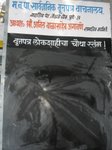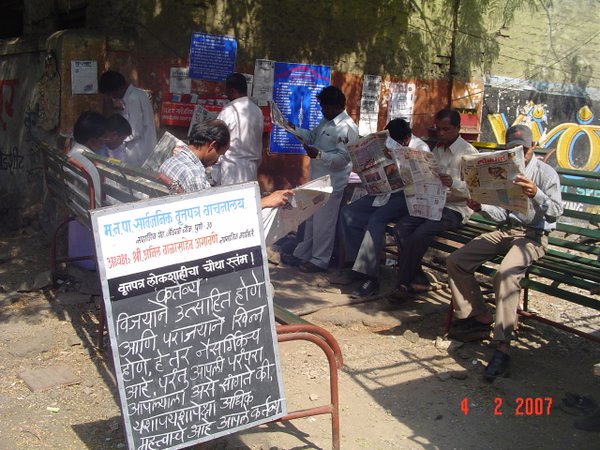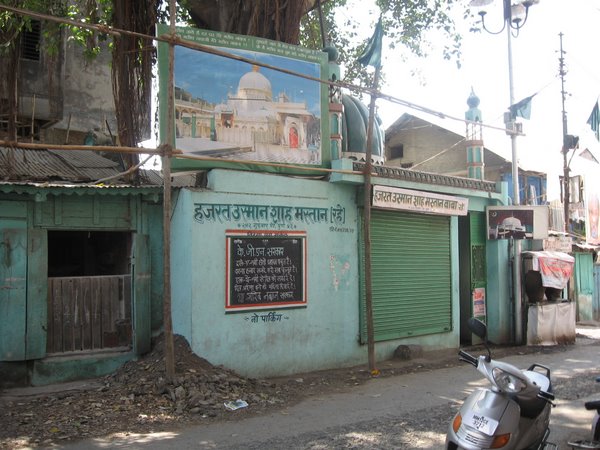(Since this post is part text and part images, I have divided it into several sections. Sorry for this ‘broken-up’ posting!)
For my fourth post I plan to profile one vartaphalak in detail. Through this I attempt to place the ‘vartaphalak’ in its larger spatial as well as social contexts to explore how it constitutes a significant community space. I rely on the photo-documentation of this area and of the vartaphalak itself to explore this aspect of vartaphalaks. This would be complemented by excerpts from the interview with Shahid (name changed), who writes the vartaphalak here and discussion with other members of this committee.
The vartaphalak featured is run by Siddi Shah Moula Young Committee, in Ghorpade Peth. Siddi Shah Maula Young Committee is an old collective, probably around 20 years old. The chairman, Ayaz Shekh told me that it was basically formed to further religious activities around the Siddi Shah Maula Durgah. It also gave an opportunity for young boys in the area to come together and interact with each other, according to him. The Committee’s activities included celebrations around Urus Sharif and Sandal Sharif, Ramzan Id and Bakri Id and the monthly Chatta, to pray to Khwaja Garib Nawaaz, wherein kheer is served to the entire locality.
The locality, Ghorpade Peth is located in east Pune and is sandwiched between several other Peths, which constitute the old, heart-of-the-city area. It resembles typical old areas characteristic in Indian urban centers: tang galiyan (narrow alleyways), densely packed, often, crumbling houses, populated by lower middle and poorer classes, the volume of traffic here making things absolutely chaotic. This area definitely retains a different sense of communal existence, than the one to be found in distinctly middle class areas like Kothrud, Prabhat Road or Model Colony, which are inhabited by almost exclusively Maharashtrian (and largely upper caste) people and are marked by apartment colonies or spacious bungalows.
The area has Muslims and Christian populations, a host of communities within Hindus like Marvadis, several middle-level caste communities like Joshi-Gondhali community, the Bhoi community and a sizeable Dalit community. This community map is based upon my interviews with several key informants and vartaphalak writers in this area.
For me, raised in an exclusively Brahmin, middle-class residential area, the landscape and soundscape of Ghorpade Peth itself seemed faintly exotic. Initially I couldn’t help but stare at the imposing 120-year-old Church of the Holy Name standing tall amidst chawls, or linger near Medina Masjid in Mominpura with smell of kabaabs wafting through the air, every time I passed the road. Nobody seemed to notice these structures amidst them as they went on with their lives. But I realized acutely, how they had never been a part of the everyday landscape that I inhabited, thus acquiring an exotic value for me. It is only now that I pass these areas with some (practiced!) nonchalance, taking the variety for granted. Hearing the church bells toll every hour or the aazan was also alien to the sound-scape that was part of my everyday life and I still notice these sounds if I’m in these areas at that time. In that sense, this was an exercise of being introduced to ‘cosmopolitanism’ for me.
For my fourth post I plan to profile one vartaphalak in detail. Through this I attempt to place the ‘vartaphalak’ in its larger spatial as well as social contexts to explore how it constitutes a significant community space. I rely on the photo-documentation of this area and of the vartaphalak itself to explore this aspect of vartaphalaks. This would be complemented by excerpts from the interview with Shahid (name changed), who writes the vartaphalak here and discussion with other members of this committee.
The vartaphalak featured is run by Siddi Shah Moula Young Committee, in Ghorpade Peth. Siddi Shah Maula Young Committee is an old collective, probably around 20 years old. The chairman, Ayaz Shekh told me that it was basically formed to further religious activities around the Siddi Shah Maula Durgah. It also gave an opportunity for young boys in the area to come together and interact with each other, according to him. The Committee’s activities included celebrations around Urus Sharif and Sandal Sharif, Ramzan Id and Bakri Id and the monthly Chatta, to pray to Khwaja Garib Nawaaz, wherein kheer is served to the entire locality.
The locality, Ghorpade Peth is located in east Pune and is sandwiched between several other Peths, which constitute the old, heart-of-the-city area. It resembles typical old areas characteristic in Indian urban centers: tang galiyan (narrow alleyways), densely packed, often, crumbling houses, populated by lower middle and poorer classes, the volume of traffic here making things absolutely chaotic. This area definitely retains a different sense of communal existence, than the one to be found in distinctly middle class areas like Kothrud, Prabhat Road or Model Colony, which are inhabited by almost exclusively Maharashtrian (and largely upper caste) people and are marked by apartment colonies or spacious bungalows.
The area has Muslims and Christian populations, a host of communities within Hindus like Marvadis, several middle-level caste communities like Joshi-Gondhali community, the Bhoi community and a sizeable Dalit community. This community map is based upon my interviews with several key informants and vartaphalak writers in this area.
For me, raised in an exclusively Brahmin, middle-class residential area, the landscape and soundscape of Ghorpade Peth itself seemed faintly exotic. Initially I couldn’t help but stare at the imposing 120-year-old Church of the Holy Name standing tall amidst chawls, or linger near Medina Masjid in Mominpura with smell of kabaabs wafting through the air, every time I passed the road. Nobody seemed to notice these structures amidst them as they went on with their lives. But I realized acutely, how they had never been a part of the everyday landscape that I inhabited, thus acquiring an exotic value for me. It is only now that I pass these areas with some (practiced!) nonchalance, taking the variety for granted. Hearing the church bells toll every hour or the aazan was also alien to the sound-scape that was part of my everyday life and I still notice these sounds if I’m in these areas at that time. In that sense, this was an exercise of being introduced to ‘cosmopolitanism’ for me.
Again, based upon the information garnered from key informant interviews and interviews with vartaphalak writers, an extremely small percentage of the population in this area is in involved in the professional realm or does ‘service’, as many of my respondents put it. A large section of the population is involved in small business or minor jobs in industries, garages and workshops. There are specific communities involved in specific occupations. The Joshi-Gondhali Samaaj, for instance, was traditionally involved in performing Gondhal, a genre of folk art in Maharashtra. Several members of this community now are involved in the business of buying old clothes, repairing and washing them and reselling them in the weekly Juna Bazaar. Similarly, the Bhois have been the palanquin bearers since medieval times. The Bhoi community is now engaged primarily in fishing and selling their catch in the city[1]. This area also seems to specialize in catering to wedding ceremonies: there are about 3-4 brass bands located here, mandap decorators, ‘ghodi’ and carriage suppliers and so on.
Coming back to Siddi Shah Moula Young Committee, Shahid gave me a bit of information about Siddi Shah Moula. The vartaphalak is in a way an extension of the durgah of Siddi Shah Moula, who was a pir, who lived in that area dosou-teensou saal pehle (2-300 years ago), according to Shahid. No one seemed to know the exact historical period to which the pir belonged, but it was clear that it was a long time ago, or bahut pehle ke as people put it.
This durgah is located in the compound of a building, next to the vartaphalak. It is a rather small structure, built of concrete adjoining the compound wall of the building. As I was later told by an old man, who owns a shop in the building, the durgah was located right in the front of the building. During the construction of the building, the builder realized that this was a special place and hence avoided breaking it down and himself constructed a small temple-like structure in the building compound, where the durgah was shifted.
[1] I have interviewed two vartaphalak writers who hailed from these communities respectively. Hence this detailed information.






















